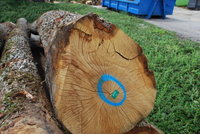 This week I feature a documentary on my visit to the Francois Freres Cooperage in Burgundy, France. I watched the barrel-making process from raw log to finished product, and you can listen to the mp3 of the audio file here .
This week I feature a documentary on my visit to the Francois Freres Cooperage in Burgundy, France. I watched the barrel-making process from raw log to finished product, and you can listen to the mp3 of the audio file here .
Photos in this blog are courtesy of my roommate, Andy Chou. I was busy recording audio, so I’m glad Andy was snapping away with his usual vigor.
In the photo at the left you can see one of the coopers moving a wet barrel onto a fire made of oak wood-scraps. The fire and water will help the staves of the barrel be bent into place by a special machine as the last hoops are placed on the bottom of the barrel.
Here are some of the oak logs the coopers start with. Francois Freres Cooperage is one of the few barrel makers that purchase the raw logs from the French forest ministry and process them into slats and age the slats for up to 3 years before making them into staves and assembling them into finished barrels.
 The logs are carefully marked and split into wedges, avoiding the use of any of the heart of the tree which may be weak or diseased. After the wedges are milled into the slats, they are stacked and placed outside in the elements for aging. The slats lose quick a bit of weight as the moisture in the wood evaporates over time.
The logs are carefully marked and split into wedges, avoiding the use of any of the heart of the tree which may be weak or diseased. After the wedges are milled into the slats, they are stacked and placed outside in the elements for aging. The slats lose quick a bit of weight as the moisture in the wood evaporates over time.
I put together some more photos in a little photo gallery so you can follow the process.
 In Canada, both the Sumac Ridge Estate Winery and the Jackson-Triggs Estate Winery (pictured at right)in BC’s Okanagan Valley use Francois Freres barrels. Sumac Ridge winemaker Mark Wendenburg prefers them to ferment his chardonnay wines, much in the same way they are used in Burgundy. At Jackson-Triggs, winemaker Brooke Blair says the barrels impart a nice, toasty smokiness to the wine.
In Canada, both the Sumac Ridge Estate Winery and the Jackson-Triggs Estate Winery (pictured at right)in BC’s Okanagan Valley use Francois Freres barrels. Sumac Ridge winemaker Mark Wendenburg prefers them to ferment his chardonnay wines, much in the same way they are used in Burgundy. At Jackson-Triggs, winemaker Brooke Blair says the barrels impart a nice, toasty smokiness to the wine.




this is an art which I was unaware and had no idea of the importance of barrels in the color or taste of wine
that’s why we learn so much in this kind of blog ……
I really loved your post and your mate Andy did you proud with those photos. Barrels are vitaly important for the wine process but I thought they would of been production made by robots to speed up the process.